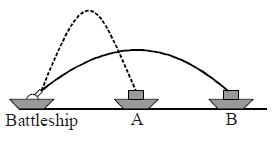A projectile of mass 100 g is fired with a velocity of 20 ms–¹ making an angle of 30° with the horizontal. As it rises to the highest point of its path, its momentum changes by (g = 10 ms–²) :
Solution:
The momentum change occurs only in the vertical direction as the horizontal component of velocity remains constant throughout the flight.
### Initial vertical component of velocity:
\[
u_y = u \sin \theta = 20 \times \sin 30^\circ = 20 \times \frac{1}{2} = 10 \, \text{m/s}
\]
At the highest point, the vertical component of velocity becomes zero.
### Change in vertical velocity:
\[
\Delta v_y = u_y - 0 = 10 \, \text{m/s}
\]
### Mass of the projectile:
\[
m = 100 \, \text{g} = 0.1 \, \text{kg}
\]
### Change in momentum:
\[
\Delta p = m \times \Delta v_y = 0.1 \times 10 = 1 \, \text{kg m/s}
\]
Thus, the change in momentum is \( 1 \, \text{kg m/s} \).
